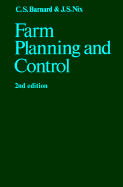Book contents
- Frontmatter
- Contents
- Notice to readers
- Preface to the first edition
- Preface to the second edition
- Selected metric conversion factors
- Part I The organisation of resources
- 1 The planning environment and the managerial function
- 2 Basic principles and concepts of planning
- 3 The organisation of capital – general
- 4 The organisation of capital – machinery, buildings and land
- 5 The organisation of labour
- Part II The organisation of enterprises
- Part III The combination of enterprises
- Part IV The control of resources and enterprises
- Selected further reading
- Index
4 - The organisation of capital – machinery, buildings and land
Published online by Cambridge University Press: 01 June 2011
- Frontmatter
- Contents
- Notice to readers
- Preface to the first edition
- Preface to the second edition
- Selected metric conversion factors
- Part I The organisation of resources
- 1 The planning environment and the managerial function
- 2 Basic principles and concepts of planning
- 3 The organisation of capital – general
- 4 The organisation of capital – machinery, buildings and land
- 5 The organisation of labour
- Part II The organisation of enterprises
- Part III The combination of enterprises
- Part IV The control of resources and enterprises
- Selected further reading
- Index
Summary
MACHINERY
Annual machinery costs average between 15 and 20 per cent of total costs on most types of farm in the U.K., except for non-intensive arable holdings, where the figure is 20 to 25 per cent. Over £300 millions are spent each year by British farmers on tractors and other machinery. The average written-down value of machinery and equipment is currently about £125 per ha – excluding highly intensive small farms and extensive upland farms. To equip a farm exceeding l00 hectares entirely with new machinery at 1978 prices would cost £450 to £650 per ha, according to the choice of enterprises and the degree of specialisation, even without any undue elaboration. The cost on the smaller farm would be considerably greater and could only be kept down by a combination of specialisation, buying second-hand and hiring contractors.
Every extra £10 per ha spent on machinery adds between £2.50 and £4.50 per ha to annual machinery expenses, if interest on capital is included. The question is whether this extra cost is worthwhile.
Justification for mechanization
Reduced drudgery
Expenditure which eliminates or at least reduces sheer hard and dirty work may have little or no immediate economic justification. Examples are expensive equipment for fully automated grain handling or slurry and farmyard manure disposal, sack hoists, pallett handling. In some circumstances there may be little or no cost savings to compensate for the equipment costs. However, such investments may have an indirect benefit in helping to attract and retain good quality staff.
- Type
- Chapter
- Information
- Farm Planning and Control , pp. 80 - 125Publisher: Cambridge University PressPrint publication year: 1980



